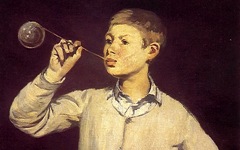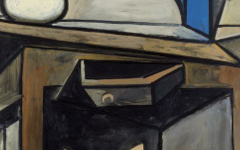Chardin’s The Soap Bubble (c.1733-4)
All art intentionally represents the mind of the visual poet who made it regardless of the apparent subject matter. That revolutionary point-of-view (revolutionary, that is, among professional writers but common knowledge among poets who paint) implies that art is always a "self-portrait" as the late Lucian Freud admitted. Speaking about artists in general he said, “Nobody is representing anything...Everything is autobiographical and everything is a portrait, even if it’s a chair.” How can that be? In the twentieth century, after art was freed from the restrictions of illusionism, the definition of self-portraiture (again, only among writers and their readers) expanded way beyond physiognomic depictions of the artist's face. Self-portraiture now includes depictions of the artist's name, objects associated with the artist, fragments of their bodies, self-representational symbols etc. etc. However, some of these "innovations" are not new at all and have been in long use as shown on EPPH. The most surprising perhaps is the self-portrait transformed and fragmented through metamorphosis. This technique began at least as early as the Middle Ages when artists hid facial features in the convoluted, and otherwise meaningless, folds of medieval drapery but it has continued ever since. I would be surprised, for instance, if any painting by Chardin was not a self-portrait. If the so-called "still-life artist" of the 18th century did paint something other than a self-portrait, I have not seen it yet. Here's an example.

Top: Chardin, The Soap Bubble (c.1734) Oil on canvas. 24 x 25 ins. Metropolitan Museum, New York.
Bottom: Chardin, The Soap Bubble (1733-34) Oil on canvas. 37 x 29 ins. National Gallery of Art, Washington DC.
Click image to enlarge.
Two versions of Chardin's The Soap Bubble are owned by museums in New York and Washington, respectively (top and bottom). The capital has the larger one and, though they look similar, their construction is different. As explained in an earlier entry titled Manet's and Chardin's Soap Bubbles the bubble-blower in both represents an artist with idealized features using his straw like a pen or brush to "draw the bubble." He is the artist's alter ego, not a self-portrait per se but a self-representation. Nevertheless he did include the likeness of his own face.
Click next thumbnail to continue

Left, top and bottom: Detail and diagram of Chardin's The Soap Bubble (New York)
Right top: Detail of Chardin's Self-portrait (1775) Louvre, Paris.
Click image to enlarge.
In the New York version Chardin has manipulated the fingers and hand of his alter ego into a phsyiognomic rendering of his own face thereby communicating the unity of his craft (hand) and mind (head). It is an age-old idea newly expressed. He has an "open eye" on the far side for exterior vision (see diagram); the other one closed, as is also traditional, for insight. His nostril can be seen in the line between his two fingers below and his lips in the finger below that.1 The straw, representing his "brush", passes right behind his open eye". [For a similar transformation, see Titian's Pope Paul III and His Grandsons (1545-6).]
Click next thumbnail to continue
When he created a slightly different composition for the Wasington version, he enlarged the scene to include ivy climbing up the wall. The same hand, though, less precisely drawn (right), does not look so metamorphically like his face.
Click next thumbnail to continue

L, top and bottom: Detail and diagram of Chardin's The Soap Bubble (Washington, DC)
R, top and bottom: Detail of Chardin's Self-portrait with Spectacles (1771)
Click image to enlarge.
Instead of including a "self-portrait-hand" in this version Chardin added some vines on the left to frame the principal figure. Take a look at the portion in the lower left corner just below his signature (top left). It is shaped to resemble his glasses with his eye on the right formed in the stone wall behind. The "eye" peers out above the "spectacles" as in a later self-portrait (top right). [Click image to enlarge] Beneath his name the eye-forms signal that the entire image above is inside his head. And, in using the vine to convey the pathways of his perception, Chardin symbolizes his mind as both intoxicated and fertile.
Chardin's scenes are not, as long believed, "proto-photojournalism" in any sense. They are instead imaginative reflections of his own mental processes. And that, today, is a self-portrait.
More Works by Chardin
Notes:
1. Although the self-portrait is from many years later - no youthful self-portraits survive - there is no reason the essential shape and proportion of his features should have changed substantially. Indeed, in my opinion, elderly artists often seem to portray their features more in keeping with their earlier self-portraits than with what they actually looked like later. Chardin, for instance, was 72 when he created the above self-portrait; he does not look it.
Original Publication Date on EPPH: 08 Jun 2014. © Simon Abrahams. Articles on this site are the copyright of Simon Abrahams. To use copyrighted material in print or other media for purposes beyond 'fair use', you must obtain permission from the copyright owner. Websites may link to this page without permission (please do) but may not reproduce the material on their own site without crediting Simon Abrahams and EPPH.




